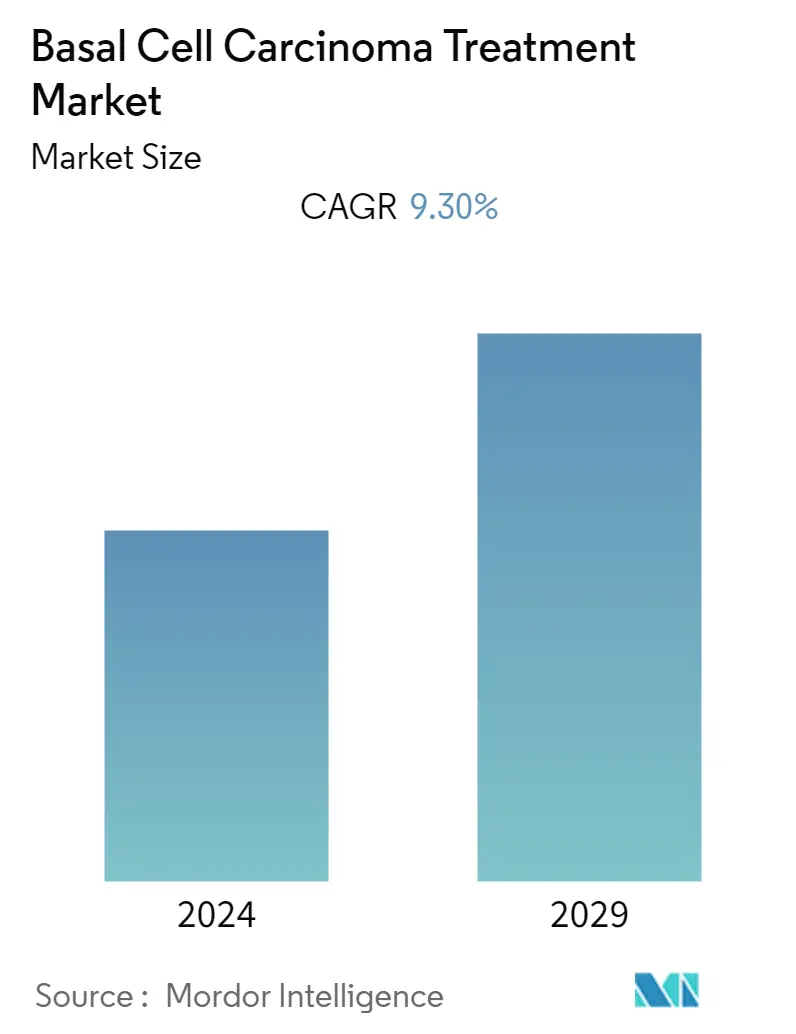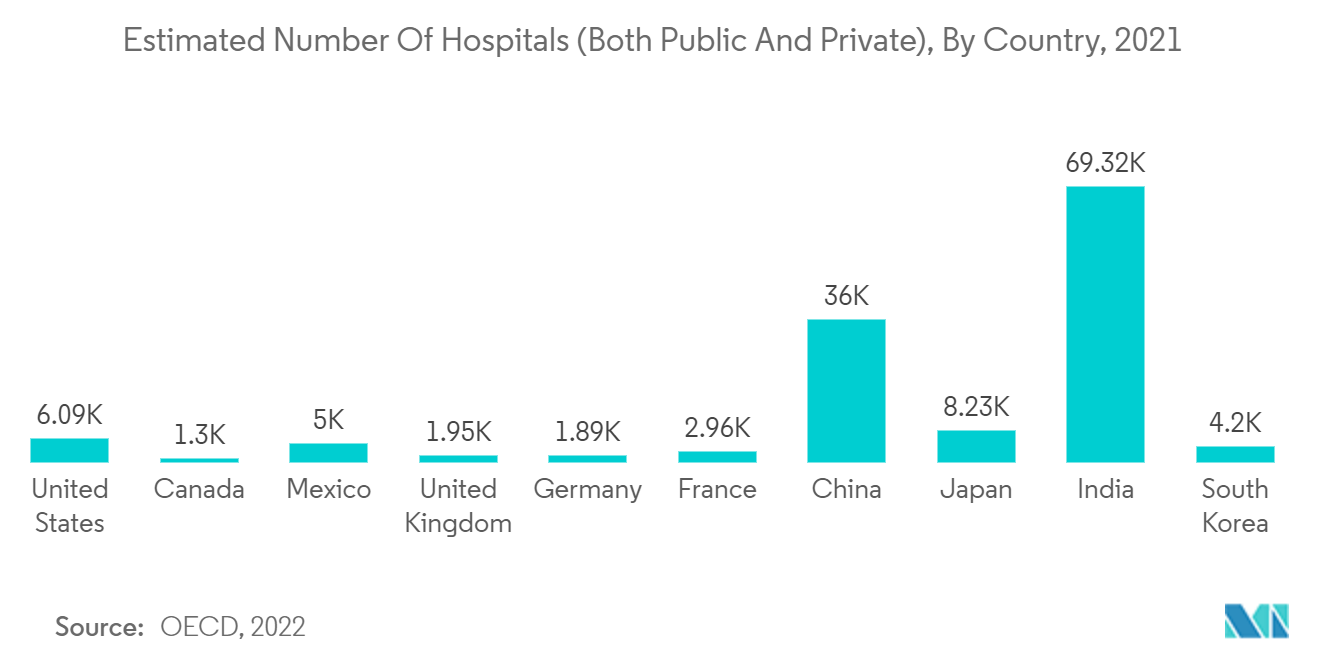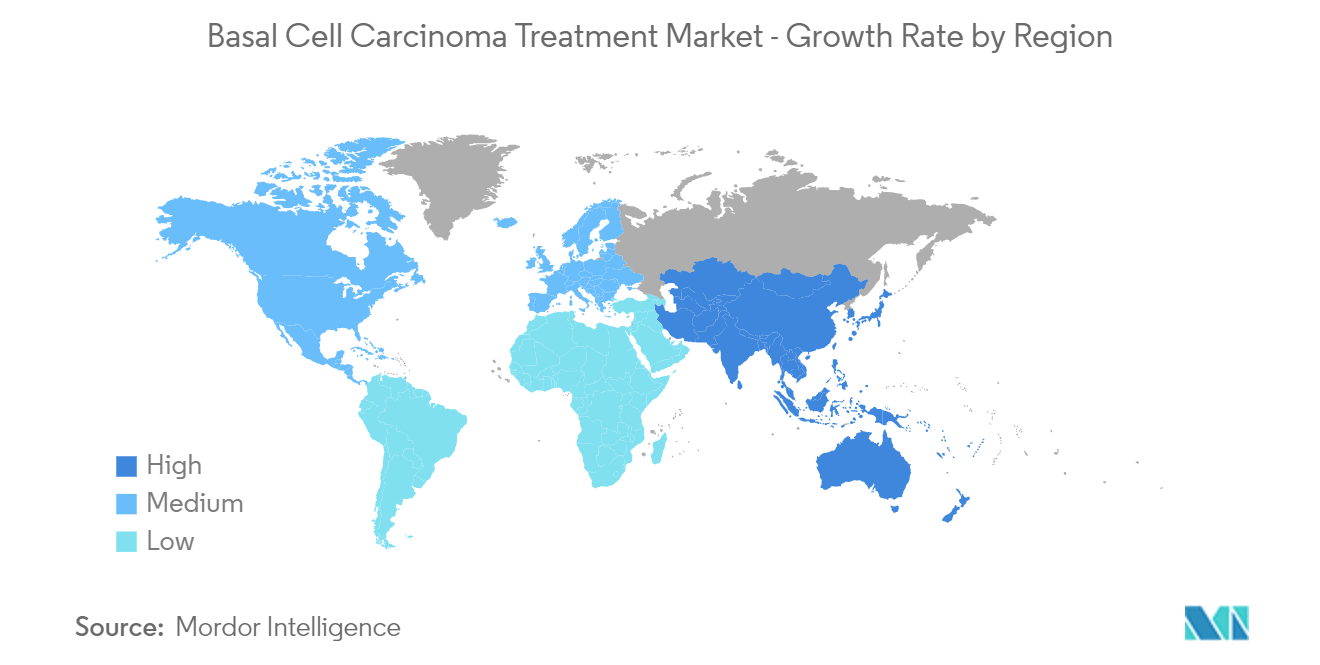Basal Cell Carcinoma Treatment Market Size

| Study Period | 2021 - 2029 |
| Base Year For Estimation | 2023 |
| CAGR | 9.30 % |
| Fastest Growing Market | Asia Pacific |
| Largest Market | North America |
| Market Concentration | Medium |
Major Players*Disclaimer: Major Players sorted in no particular order |
Basal Cell Carcinoma Treatment Market Analysis
The Basal Cell Carcinoma Treatment Market is expected to register a CAGR of 9.3% over the forecast period.
The studied market was adversely impacted by the pandemic, and several research studies have provided insights into the direct effect of the outbreak on various diagnostic and surgical procedures related to cancer. The COVID-19 pandemic resulted in a sharp decline in non-urgent medical visits, according to a research article published in the National Library of Medicine in March 2021. Delayed appointments led to serious health consequences, such as the prolonged diagnosis of melanoma and other skin malignancies. As a result, there was a sharp decrease in all skin biopsies (15% of what was predicted), keratinocyte carcinoma (KC) biopsies (18%), and melanoma biopsies (27%). Thus, the market was unfavourably impacted by the outbreak in its initial phase. However, as per the analysis, initiatives undertaken by key market players, such as product approvals and developments, are augmenting market growth in the post-pandemic phase. For instance, in February 2021, the USFDA approved the intravenous immunotherapy medication, cemiplimab-rwlc (Libtayo), for the treatment of patients with certain forms of advanced basal cell carcinoma. Thus, with such approvals, the market is expected to grow during the forecast period.
The major factors attributing to the growth of the market are the increasing prevalence of skin malignancies, a rise in various environmental factors that lead to more UV exposure, and an increasing geriatric population that is more susceptible to skin diseases. According to a March 2022 article published by WCRFI, there are two primary forms of skin cancer, namely melanoma, and non-melanoma. Squamous cell carcinoma and basal cell carcinoma are the most typical non-melanoma cancers. The 17th most prevalent cancer worldwide is cutaneous melanoma. In terms of prevalence, it ranks 15th among cancers in women and 13th among cancers in men. In 2020, there were more than 150,000 new cases of cutaneous melanoma. Similarly, according to an article published by the American Academy of Dermatology Association in April 2022, skin cancer is the most prevalent type of cancer among Americans. According to current projections, one in five Americans may have skin cancer at some point in their lives. In the United States, an estimated 9,500 people receive a skin cancer diagnosis each day. More than 3 million Americans are thought to be affected annually by nonmelanoma skin cancer (NMSC), which includes basal cell carcinoma (BCC) and squamous cell carcinoma (SCC). Thus, the increasing prevalence of skin cancer is expected to boost market demand for treatments, in turn bolstering the market's growth.
Further, growing R&D activities related to basal cell carcinoma treatment are projected to propel the market's growth. For instance, at the American Society for Dermatologic Surgery (ASDS) Annual Meeting held in October 2022, the research study by Pulse Biosciences demonstrated that the CellFX procedure is effective for low-risk superficial and nodular basal cell carcinoma lesion clearance using Nano-Pulse Stimulation (NPS) technology. Such developments, coupled with the growing incidence of cancer, are likely to boost the market's growth.
However, the high cost of treatment and high susceptibility of basal cell carcinoma to remain underdiagnosed is expected to hinder the market's growth.
Basal Cell Carcinoma Treatment Market Trends
This section covers the major market trends shaping the Basal Cell Carcinoma Treatment Market according to our research experts:
Hospital Segment is Expected to Hold a Significant Market Share Over the Forecast Period
The hospital segment is expected to hold a major share of the market by end-user segmentation over the analysis period.
The increasing healthcare expenditures, along with investment in new hospitals and the expansion of existing ones, are expected to boost growth in the studied segment over the forecast period. For example, the Indian government is developing sixteen additional AIIMS across the country in different phases. And as per the Indian Ministry of Health and Family Welfare, under Phase-V, in September 2020, INR 1,264 crore (USD 153.5 million) was approved by the cabinet for the development of AIIMS Darbhanga, which is located in the Bihar state of India. AIIMS in India is one of the major centres in India dealing with surgical oncology patients.
Furthermore, to support care for skin cancer, Hampshire Hospitals acquired new equipment, including the FotoFinder. The dermatology team's capacity to detect, track, and treat skin cancer for regional patients will be drastically altered by the FotoFinder mole mapping device.
Similarly, there are multiple projects of hospital development that are ongoing worldwide and are expected to boost the growth of the studied segment. The AHA statistics for 2022 show that the number of active hospitals in the United States increased from 5,534 in 2016 to 6,093 in 2020. Further, as per the same source, the total hospital admissions in the hospitals of the United States stood at about 33.4 million, with a total hospital expense of about USD 1.2 trillion. Thus, the increase in the number of hospitals is expected to boost growth in the studied segment. In March 2021, the Ontario government, a Canadian province, invested up to USD 41.8 million in the new Grey Bruce Health Services Markdale Hospital for expansion and other activities like the purchase of instruments.
Thus, the growing prevalence of basal cell carcinoma and the increasing number of hospital facilities providing the treatment is expected to boost the segment's growth.

North America Dominates the Market and Expected to do Same in the Forecast Period
North America is expected to dominate the overall basal cell carcinoma treatment market throughout the forecast period. This is due to the factors such as the growth in the geriatric population, surge in R&D activities by key market players, rising awareness of advanced treatments, favorable reimbursement scenarios, and high prevalence of basal cell carcinoma in this region.
The increasing number of skin disorders in the region is a key factor driving the growth of the market. For instance, in 2020, a report published by the Canadian Dermatology Association stated that around 8,000 people were suffering from melanoma skin cancer, out of which around 4,400 were men and 3,600 were women. Melanoma is now the 7th most common cancer in Canada and one of the few cancers with rising incidence rates among Canadians. The same source stated that non-melanoma skin cancer is the most common form of skin cancer. Among the non-melanoma forms, basal cell carcinoma (BCC) makes up 75% to 80% of cases, and squamous cell carcinoma (SCC), around 20%.
Furthermore, clinical trials are another factor responsible for the market's growth. The Center for Biomedical Research, Inc. completed a randomized comparative trial of a 30% solution of ascorbic acid in 95% dimethylsulfoxide applied topically twice a day for 8 weeks vs. 5% imiquimod cream in the treatment of biopsy-proven basal cell carcinomas in otherwise healthy adult patients in November 2021. A biopsy-verified remission of the malignancy served as an outcome measure. Thus, such clinical trials are expected to provide insight into the new methods to be used for the treatment of basal cancer.
Hence, such factors are altogether contributing to the growth of the market over the forecast period.

Basal Cell Carcinoma Treatment Industry Overview
The basal cell carcinoma treatment market is moderately competitive and consists of several major players. Some of the companies that are currently dominating the market are Merck & Co., Inc., Bausch Health Companies, F. Hoffmann-La Roche Ltd., Mylan N.V., Sun Pharmaceuticals Ltd., Allergan Inc., Perrigo Company Plc., and Strides Arcolab Ltd., among others.
Basal Cell Carcinoma Treatment Market Leaders
-
Bausch Health Companies Inc.
-
F. Hoffmann-La Roche AG
-
Mylan N.V.
-
Sun Pharmaceuticals Ltd.
-
Merck & Co. Inc.
*Disclaimer: Major Players sorted in no particular order

Basal Cell Carcinoma Treatment Market News
- In June 2021, the PD-1 inhibitor Libtayo, developed by Regeneron Pharmaceuticals, Inc., and Sanofi, was authorized by the European Commission (EC) to treat adults with locally advanced or metastatic basal cell carcinoma (BCC) who have progressed on or are intolerant to a hedgehog pathway inhibitor (HHI).
- In February 2021, Sanofi's PD-1 inhibitor Libtayo, the first immunotherapy recommended for patients with advanced basal cell carcinoma, received USFDA approval.
Basal Cell Carcinoma Treatment Market Report - Table of Contents
1. INTRODUCTION
- 1.1 Study Assumptions and Market Definition
- 1.2 Scope of the Study
2. RESEARCH METHODOLOGY
3. EXECUTIVE SUMMARY
4. MARKET DYNAMICS
- 4.1 Market Overview
-
4.2 Market Drivers
- 4.2.1 Increasing Prevalence of Skin Cancers
- 4.2.2 Increase in Geriatric Population
- 4.2.3 Environmental Factors Leading to Greater Exposure of UV Radiation
-
4.3 Market Restraints
- 4.3.1 High Cost of Treatment
- 4.3.2 High Susceptibility of Basal Cell Carcinoma to remain Under-diagnosed
-
4.4 Porter's Five Force Analysis
- 4.4.1 Threat of New Entrants
- 4.4.2 Bargaining Power of Buyers/Consumers
- 4.4.3 Bargaining Power of Suppliers
- 4.4.4 Threat of Substitute Products
- 4.4.5 Intensity of Competitive Rivalry
5. MARKET SEGMENTATION (Market Size by Value - USD million)
-
5.1 By Treatment Type
- 5.1.1 Surgery
- 5.1.2 Medication
- 5.1.3 Others
-
5.2 By End User
- 5.2.1 Hospitals
- 5.2.2 Specialty Clinics
- 5.2.3 Others
-
5.3 Geography
- 5.3.1 North America
- 5.3.1.1 United States
- 5.3.1.2 Canada
- 5.3.1.3 Mexico
- 5.3.2 Europe
- 5.3.2.1 Germany
- 5.3.2.2 United Kingdom
- 5.3.2.3 France
- 5.3.2.4 Italy
- 5.3.2.5 Spain
- 5.3.2.6 Rest of Europe
- 5.3.3 Asia-Pacific
- 5.3.3.1 China
- 5.3.3.2 Japan
- 5.3.3.3 India
- 5.3.3.4 Australia
- 5.3.3.5 South Korea
- 5.3.3.6 Rest of Asia-Pacific
- 5.3.4 Middle East and Africa
- 5.3.4.1 GCC
- 5.3.4.2 South Africa
- 5.3.4.3 Rest of Middle East and Africa
- 5.3.5 South America
- 5.3.5.1 Brazil
- 5.3.5.2 Argentina
- 5.3.5.3 Rest of South America
6. COMPETITIVE LANDSCAPE
-
6.1 Company Profiles
- 6.1.1 Abbvie (Allergan)
- 6.1.2 Bausch Health Companies Inc.
- 6.1.3 F. Hoffmann-La Roche AG
- 6.1.4 Medivir AB
- 6.1.5 Merck & Co. Inc
- 6.1.6 PellePharm
- 6.1.7 Perrigo Company plc
- 6.1.8 Sanofi
- 6.1.9 Strides Arcolab Ltd
- 6.1.10 Sun Pharmaceuticals Ltd
- 6.1.11 Taro Pharmaceutical Industries Ltd
- 6.1.12 Viatris
- *List Not Exhaustive
7. MARKET OPPORTUNITIES AND FUTURE TRENDS
** Subject To AvailablityBasal Cell Carcinoma Treatment Industry Segmentation
As per the scope of the report, basal cell carcinoma is a type of skin cancer that begins in the basal cells, which produce new cells when the old ones die. The Basal Cell Carcinoma Treatment market is segmented by Treatment Type (Surgery, Medication, and Others), End-User (Hospitals, Specialty Clinics, and Others), and Geography (North America, Europe, Asia-Pacific, Middle East and Africa, and South America). The market report also covers the estimated market sizes and trends for 17 different countries across the major regions globally. The report offers the value (in USD million) for the above segments.
| By Treatment Type | Surgery | |
| Medication | ||
| Others | ||
| By End User | Hospitals | |
| Specialty Clinics | ||
| Others | ||
| Geography | North America | United States |
| Canada | ||
| Mexico | ||
| Geography | Europe | Germany |
| United Kingdom | ||
| France | ||
| Italy | ||
| Spain | ||
| Rest of Europe | ||
| Geography | Asia-Pacific | China |
| Japan | ||
| India | ||
| Australia | ||
| South Korea | ||
| Rest of Asia-Pacific | ||
| Geography | Middle East and Africa | GCC |
| South Africa | ||
| Rest of Middle East and Africa | ||
| Geography | South America | Brazil |
| Argentina | ||
| Rest of South America |
Basal Cell Carcinoma Treatment Market Research FAQs
What is the current Basal Cell Carcinoma Treatment Market size?
The Basal Cell Carcinoma Treatment Market is projected to register a CAGR of 9.30% during the forecast period (2024-2029)
Who are the key players in Basal Cell Carcinoma Treatment Market?
Bausch Health Companies Inc., F. Hoffmann-La Roche AG, Mylan N.V., Sun Pharmaceuticals Ltd. and Merck & Co. Inc. are the major companies operating in the Basal Cell Carcinoma Treatment Market.
Which is the fastest growing region in Basal Cell Carcinoma Treatment Market?
Asia Pacific is estimated to grow at the highest CAGR over the forecast period (2024-2029).
Which region has the biggest share in Basal Cell Carcinoma Treatment Market?
In 2024, the North America accounts for the largest market share in Basal Cell Carcinoma Treatment Market.
What years does this Basal Cell Carcinoma Treatment Market cover?
The report covers the Basal Cell Carcinoma Treatment Market historical market size for years: 2021, 2022 and 2023. The report also forecasts the Basal Cell Carcinoma Treatment Market size for years: 2024, 2025, 2026, 2027, 2028 and 2029.
Basal Cell Carcinoma Industry Report
Statistics for the 2023 Basal Cell Carcinoma market share, size and revenue growth rate, created by Mordor Intelligence™ Industry Reports. Basal Cell Carcinoma analysis includes a market forecast outlook to 2029 and historical overview. Get a sample of this industry analysis as a free report PDF download.



